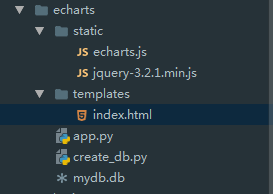这里摘抄一篇通俗易懂的文章,方便大家与后端衔接。。。。。。。
使用python的web框架Flask作为后台,数据存储使用sqllite3,前端的展示用开源图标插件echarts。
使用sqllite作为数据库存储数据,创建create_db.py,这里是虚拟数据,思路也是参考别人的博客
# coding=utf-8
import sqlite3
import sys
reload(sys)
sys.setdefaultencoding('utf-8')
# 连接
conn = sqlite3.connect('mydb.db')
conn.text_factory = str
c = conn.cursor()
# 创建表
c.execute('''DROP TABLE IF EXISTS weather''')
c.execute('''CREATE TABLE weather (month text, evaporation text, precipitation text)''')
# 数据
# 格式:月份,蒸发量,降水量
purchases = [('1月', 2, 2.6),
('2月', 4.9, 5.9),
('3月', 7, 9),
('4月', 23.2, 26.4),
('5月', 25.6, 28.7),
('6月', 76.7, 70.7),
('7月', 135.6, 175.6),
('8月', 162.2, 182.2),
('9月', 32.6, 48.7),
('10月', 20, 18.8),
('11月', 6.4, 6),
('12月', 3.3, 2.3)
]
# 插入数据
c.executemany('INSERT INTO weather VALUES (?,?,?)', purchases)
# 提交!!!
conn.commit()
# 查询方式一
for row in c.execute('SELECT * FROM weather'):
print(row)
# 查询方式二
c.execute('SELECT * FROM weather')
print(c.fetchall())
# 查询方式二_2
res = c.execute('SELECT * FROM weather')
print(res.fetchall())
# 关闭
conn.close()
使用python的web框架flask,搭建一个简答的后台系统
app.py
import sqlite3
from flask import Flask, request, render_template, jsonify
import sys
reload(sys)
sys.setdefaultencoding('utf-8')
app = Flask(__name__)
def get_db():
db = sqlite3.connect('mydb.db')
db.row_factory = sqlite3.Row
return db
def query_db(query, args=(), one=False):
db = get_db()
cur = db.execute(query, args)
db.commit()
rv = cur.fetchall()
db.close()
return (rv[0] if rv else None) if one else rv
@app.route("/", methods=["GET"])
def index():
return render_template("index.html")
@app.route("/weather", methods=["GET"])
def weather():
if request.method == "GET":
res = query_db("SELECT * FROM weather")
return jsonify(month=[x[0] for x in res],
evaporation=[x[1] for x in res],
precipitation=[x[2] for x in res])
@app.route('/map')
def map():
return render_template('map.html')
if __name__ == "__main__":
app.run(debug=True)
最后在前端页面展示数据,使用百度开源图表插件echarts
<!DOCTYPE html>
<html lang="en">
<head>
<meta charset="utf-8">
<title>ECharts3 Ajax</title>
<script src="{{ url_for('static', filename='jquery-3.2.1.min.js') }}"></script>
<script src="{{ url_for('static', filename='echarts.js') }}"></script>
</head>
<body>
<!--为ECharts准备一个具备大小(宽高)的Dom-->
<div id="main" style="height:500px;border:1px solid #ccc;padding:10px;"></div>
<script type="text/javascript">
var myChart = echarts.init(document.getElementById('main'));
// 显示标题,图例和空的坐标轴
myChart.setOption({
title: {
text: '异步数据加载示例'
},
tooltip: {},
legend: {
data:['蒸发量','降水量']
},
xAxis: {
data: []
},
yAxis: {},
series: [{
name: '蒸发量',
type: 'line',
data: []
},{
name: '降水量',
type: 'bar',
data: []
}]
});
myChart.showLoading(); // 显示加载动画
// 异步加载数据
$.get('/weather').done(function (data) {
myChart.hideLoading(); // 隐藏加载动画
// 填入数据
myChart.setOption({
xAxis: {
data: data.month
},
series: [{
name: '蒸发量', // 根据名字对应到相应的系列
data: data.evaporation.map(parseFloat) // 转化为数字(注意map)
},{
name: '降水量',
data: data.precipitation.map(parseFloat)
}]
});
});
</script>
</body>
</html>
项目结构如下图所示:

最后运行flask项目,python app.py runserver即可,访问127.0.0.1:5000



